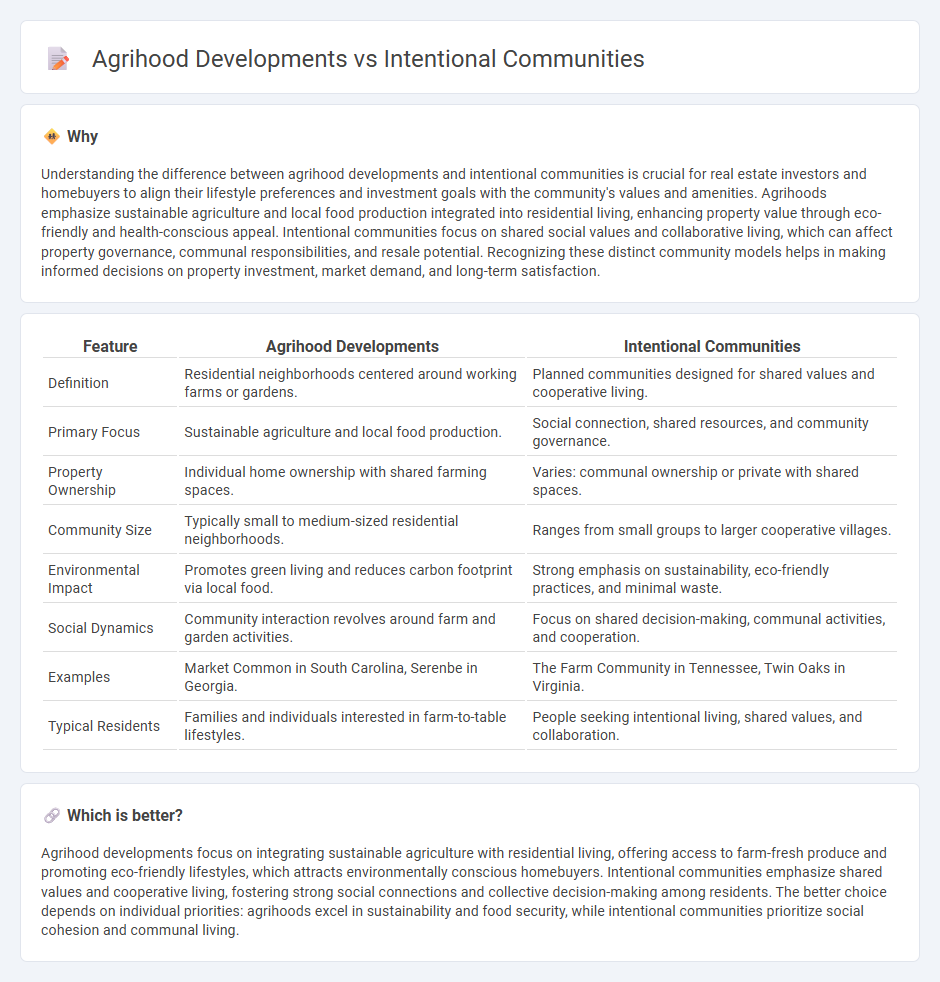
Agrihood developments focus on integrating sustainable agriculture and residential living by incorporating community farms, gardens, and green spaces within housing projects, promoting local food production and environmental stewardship. Intentional communities emphasize shared values and collaborative living arrangements, often featuring co-housing designs, communal facilities, and social engagement to foster strong neighbor connections. Discover how agrihoods and intentional communities are transforming real estate by combining lifestyle preferences with innovative community planning.
Why it is important
Understanding the difference between agrihood developments and intentional communities is crucial for real estate investors and homebuyers to align their lifestyle preferences and investment goals with the community's values and amenities. Agrihoods emphasize sustainable agriculture and local food production integrated into residential living, enhancing property value through eco-friendly and health-conscious appeal. Intentional communities focus on shared social values and collaborative living, which can affect property governance, communal responsibilities, and resale potential. Recognizing these distinct community models helps in making informed decisions on property investment, market demand, and long-term satisfaction.
Comparison Table
| Feature | Agrihood Developments | Intentional Communities |
|---|---|---|
| Definition | Residential neighborhoods centered around working farms or gardens. | Planned communities designed for shared values and cooperative living. |
| Primary Focus | Sustainable agriculture and local food production. | Social connection, shared resources, and community governance. |
| Property Ownership | Individual home ownership with shared farming spaces. | Varies: communal ownership or private with shared spaces. |
| Community Size | Typically small to medium-sized residential neighborhoods. | Ranges from small groups to larger cooperative villages. |
| Environmental Impact | Promotes green living and reduces carbon footprint via local food. | Strong emphasis on sustainability, eco-friendly practices, and minimal waste. |
| Social Dynamics | Community interaction revolves around farm and garden activities. | Focus on shared decision-making, communal activities, and cooperation. |
| Examples | Market Common in South Carolina, Serenbe in Georgia. | The Farm Community in Tennessee, Twin Oaks in Virginia. |
| Typical Residents | Families and individuals interested in farm-to-table lifestyles. | People seeking intentional living, shared values, and collaboration. |
Which is better?
Agrihood developments focus on integrating sustainable agriculture with residential living, offering access to farm-fresh produce and promoting eco-friendly lifestyles, which attracts environmentally conscious homebuyers. Intentional communities emphasize shared values and cooperative living, fostering strong social connections and collective decision-making among residents. The better choice depends on individual priorities: agrihoods excel in sustainability and food security, while intentional communities prioritize social cohesion and communal living.
Connection
Agrihood developments integrate sustainable agriculture into residential neighborhoods, fostering intentional communities centered around shared values of environmental stewardship and local food production. These communities prioritize collective living experiences, combining green spaces, community gardens, and farm-to-table resources to enhance social bonds and promote healthy lifestyles. Agrihoods serve as a model for real estate projects that blend residential comfort with ecological mindfulness and community engagement.
Key Terms
Cohousing
Intentional communities like cohousing emphasize shared spaces and collaborative living, fostering strong social connections and sustainable lifestyles. Agrihood developments integrate residential living with active farming, promoting local food production and environmental stewardship within the neighborhood. Explore more to understand how cohousing models create vibrant communities centered on cooperation and shared values.
Sustainable Agriculture
Intentional communities prioritize collective living and shared resources with a strong emphasis on sustainable agriculture practices such as organic farming, permaculture, and community-supported agriculture (CSA). Agrihood developments integrate residential living with functioning farms, focusing on sustainable food production and enhancing local biodiversity while promoting eco-friendly landscaping and water conservation techniques. Explore how these innovative community models transform sustainable agriculture and urban living.
Shared Amenities
Intentional communities often prioritize communal spaces such as co-housing kitchens, shared gardens, and collaborative workspaces designed to foster social interaction and collective decision-making. Agrihood developments emphasize shared amenities centered around sustainable agriculture, including community farms, farmers' markets, and educational workshops on organic farming. Explore further to understand how these shared amenities influence community lifestyle and engagement.
Source and External Links
Intentional Communities: The Beginners Guide - A guide for those interested in exploring intentional communities, which are groups living together based on shared values and cooperative practices.
List of intentional communities - A comprehensive list of planned residential communities around the world that foster social cohesion and teamwork.
Intentional community - A voluntary residential community designed to promote teamwork and social cohesion, often with a focus on specific values or lifestyles.
 dowidth.com
dowidth.com